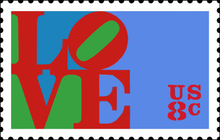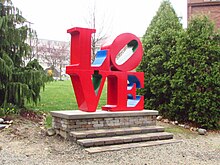Love (sculpture)
Love is a pop art image by American artist Robert Indiana. It consists of the letters L and O over the letters V and E in bold Didone type; the O is slanted sideways so that its oblong negative space creates a line leading to the V. The original image, with green and blue spaces backing red lettering, served as a print image for a Museum of Modern Art Christmas card in 1965. In much this same form the design soon graced a popular United States postage stamp.[1] Love's original rendering in sculpture was made in 1970 and is displayed in Indiana at the Indianapolis Museum of Art. The material is COR-TEN steel.[2] Indiana's Love design has since been reproduced in a variety of formats for rendering in displays around the world.
Significance[edit]
Original inspirations[edit]

MoMA historian Deborah Wye[3] describes Indiana's image as "full of erotic, religious, autobiographical, and political underpinnings" that make it "both accessible and complex in meaning."[3][4] Megan Wilde offered more detail about the autobiographical origins in an article for Mental Floss magazine, "[T]he word love was connected to [the artist's] childhood experiences attending a Christian Science church, where the only decoration was the wall inscription "God is Love". The colors were an homage to his father, who worked at a Phillips 66 gas station during the Depression". She quotes Robert Indiana as describing the original colors as "the red and green of that sign against the blue Hoosier sky".[5]
Indiana got inspired by the work of his former partner, artist Ellsworth Kelly. "He introduced me to Hard-Edge and was a great influence on my work, and is responsible for my being here" said Indiana.[6]
Acquired associations[edit]
Indiana's image was quickly adapted upon its appearance in the 1960s by the hippie free love movement and again in the 1990s by skateboard enthusiasts after skateboarding was banned in Philadelphia's Love Park.[7]
Versions[edit]

Versions of the sculpture now exist in Hebrew, Chinese, Italian and Spanish, as well as the original English.
The image has been rendered and parodied in many forms. After the 1965 MoMA card, one of the early commercial uses of the image was on the LP cover of the 1967 studio recording of Olivier Messiaen's Turangalila Symphony, featuring the Toronto Symphony Orchestra conducted by Seiji Ozawa (RCA LSC-7051). The original book cover for Erich Segal's 1970 novel Love Story alluded to the design, and the TV series Bridget Loves Bernie included a shot of the Sixth Avenue sculpture in its opening credits. The first opening sequence of the Skip Beat! anime includes the image in the initial frames. The United States Post Office issued an eight-cent stamp in 1973 featuring the image. Parodies of the image appeared on covers of records by Rage Against the Machine (Renegades), Oasis ("Little by Little" single) and Acen Razvi (75 Minutes). London artist D*Face parodied the image by rendering the word "hate" with the "A" tilted and Belgian artist Eddy Gabriel made a version using the word "lost".[8] The sculpture is remade to read "THPS" in the Xbox expansion of Tony Hawk's Pro Skater 2, which has a stage set in Philadelphia's Love Park. The set reappears in Tony Hawk's Underground 2 and Tony Hawk's Proving Ground.
On February 14, 2011, Google posted a special Valentine's Day edition of its logo based on the famous image.
Amor, National Sculpture Garden, Washington, DC[9]
In Hebrew, at The Israel Museum, Jerusalem
References[edit]
| Wikimedia Commons has media related to Love by Robert Indiana. |
- ^ (1) "Love" (PDF). American Philatelic Society. 2011. pp. 1–13. Archived from the original (PDF) on 2016-08-03. Retrieved 2018-01-07.
(2) "8-Cent Special Stamp for Someone Special" (PDF). Postal Bulletin. Washington, D.C.: United States Postal Service (20904): 3. 1972-12-21. Archived from the original (PDF) on 2018-05-13. Retrieved 2018-05-12.
(3) "Love (1973)". Art of the Stamp. Smithsonian National Postal Museum. Archived from the original on 2018-01-07. Retrieved 2018-01-18.
(4) Piazza, Daniel (2008-08-15). "Love Issue". Arago: People, Postage & The Post (Philately). Washington, D.C.: Smithsonian National Postal Museum. Archived from the original on 2016-02-03. Retrieved 2018-05-12.
(5) Baadke, Michael (1998-11-30). "Special stamps to convey special messages". Linn's Stamp News. Amos Media Company. Archived from the original on 2018-01-18. Retrieved 2018-05-13.The first U.S. Love stamp was an 8¢ issue (Scott 1475) that resembled many commemorative stamps from 1973: it was multicolor and about twice the size of the 8¢ Dwight D. Eisenhower definitive stamp (Scott 1394) issued a couple of years before. .... The Postal Service printed 320 million of those Love stamps, about twice the normal print run for a commemorative stamp in those days. .... A publication of the USPS Stamps Division described the issue as "A Special Stamp for Someone Special."
(6) "1973 "Love" stamp first day of issue cover". FDCs of Commemorative Stamps ~ 1973. SwapMeetDave. 1973-01-26. Archived from the original (photograph) on 2018-05-13. Retrieved 2018-05-13. - ^ "Love" (sculpture), Explore Art: IMA Collections. Retrieved 5 March 2013.
- ^ a b Deborah Wye, Artists and Prints: Masterworks from The Museum of Modern Art, New York: The Museum of Modern Art, 2004, p. 166
- ^ "MoMA". MoMA.org.
- ^ "Masterpieces: Robert Indiana's Love". Mental Floss.
- ^ "Robert Indiana on 50 Years of Art, and the Fraught Life of "LOVE"". Artspace. Retrieved 2020-04-06.
- ^ Free Love Park, Philadelphia PA
- ^ witzenstein. "Witzenstein". witzenstein.blogspot.com.
- ^ "Archived copy". Archived from the original on 2014-05-08. Retrieved 2014-05-07.CS1 maint: archived copy as title (link)




